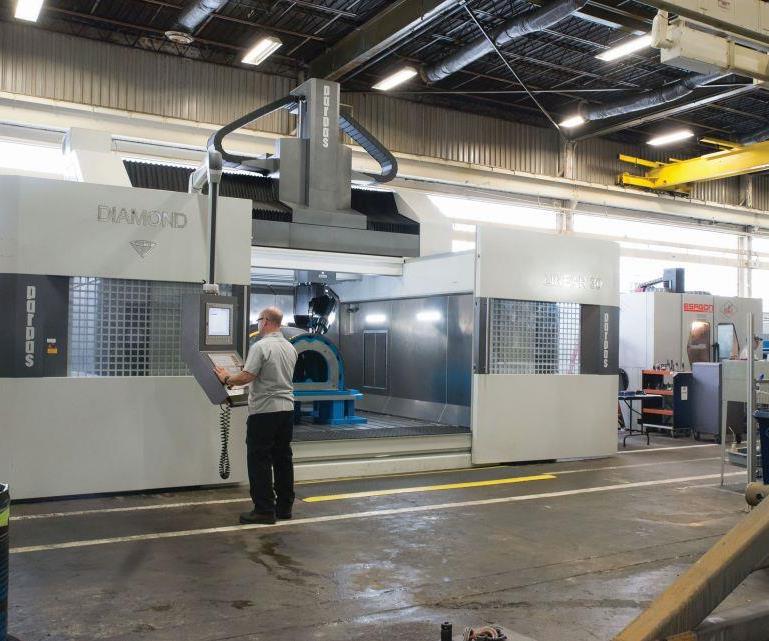Share




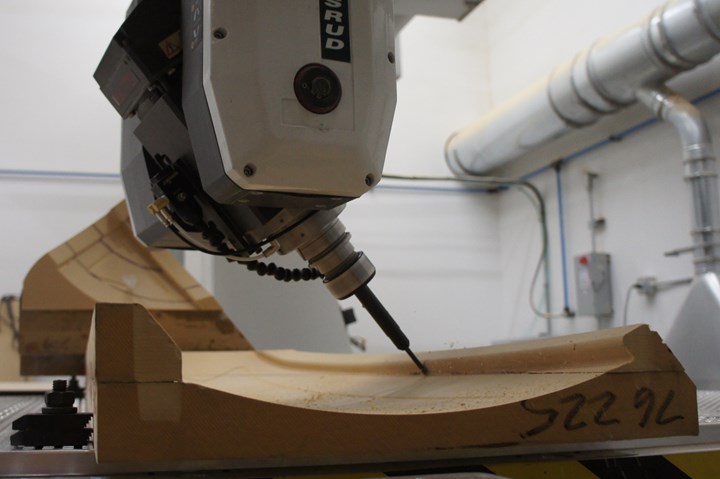
In addition to machining parts, the new five-axis machine trims porous vacuum workholding fixtures to precisely match and form a seal with the underside of the part. This shot depicts the machining of a part-seating undercut in a medium-density fiberboard fixture.
DeltaWing Manufacturing knows composites. Most of the company’s 30 employees are dedicated to some critical step in manufacturing composite components, from making the molds to curing (hardening) the parts in a massive autoclave (a pressurized oven). However, composites expertise isn’t DeltaWing’s only asset. Kevin Bialas, vice president of manufacturing, says CNC machining has always been considered a core competency.
Without this and other value-added services, the company’s recent growth would not have been possible, he says. Likewise, future growth requires futher investments in machining. The most recent is a milling machine that occupies a space nearly as large as the one dedicated to the autoclave. By bringing critical pattern-making operations in house and eliminating tedious hand-trimming work, DeltaWing’s advance into large-capacity, five-axis machining has been and will continue to be essential for expanding beyond the company’s auto-racing roots.
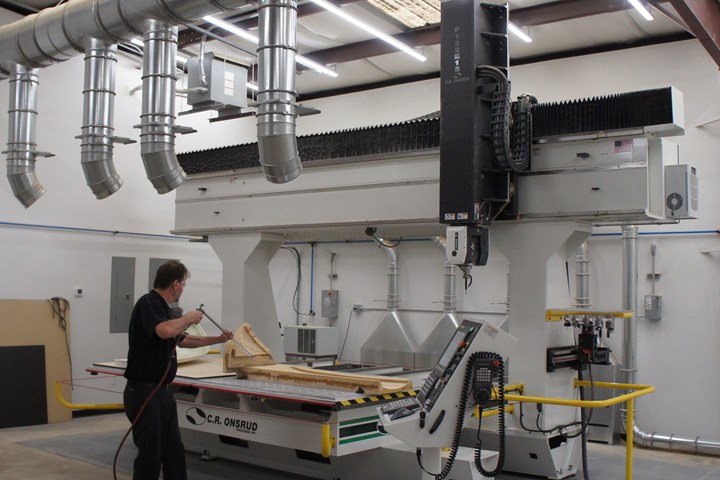
Filtration is critical for both safety and quality machining. At DeltaWing, large blowers direct waste material into collection units behind the machine.
Auto to Aero
Race cars still greet visitors to DeltaWing’s 40,000-square-foot facility outside Atlanta, and the company is still involved in that business. However, a look beyond the lobby reveals a deeper focus on structures and assemblies for planes, drones, and increasingly, commercial vehicles. Most are made from carbon fiber reinforced plastic (CFRP) or glass fiber reinforced plastic (fiberglass). A good portion could not be photographed. CNC machining contributed to the growth that made this shift possible in three ways:
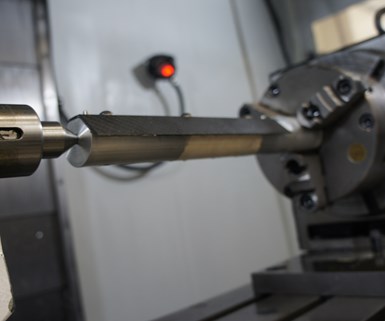
Many composite parts, such as this rifle heat shield, are trimmed on the company’s smaller VMCs. In this case, a rotary fourth axis enabled machining the chamfered edges, which must be 90-degrees to the part face, without a custom fixture.
1. Providing a profit center.
Shortly after the 1997 founding of DeltaWing’s predecessor company, race car builder Elan Technologies, the in-house machine shop began producing discrete metal parts for customers in addition to fixtures for internal use. Since the company began pursuing aerospace parts in earnest about five years ago, capacity has increasingly been filled by more sophisticated prototype parts in aluminum, steel and titanium. Many are for sensitive defense applications.

Composite assemblies often incorporate metal parts like these brackets, which underwent operations on both the waterjet and the company’s 4-axis CNC press brake.
2. Facilitating a complete service.
Along with the press brakes and other equipment in the fabricating area (including a new waterjet for large 2D work), the machining division provides metal portions of composite structures that are built in house. These include both metal parts that are assembled with composites and metal parts that serve as cores — essentially, “skeletons” that provide strength to the surrounding composite structure. Combining machining, fabricating and assembly services with composites manufacturing helps customers simplify their supply chains.
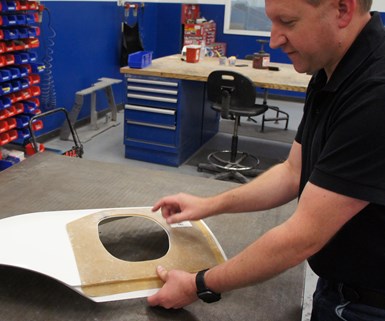
Particularly for large and complex parts, CNC machining provides DeltaWing with a faster, more accurate means of trimming composite components than traditional manual processes employing jigs like the one demonstrated here by Kevin Bialas, vice president of manufacturing.
3. Finishing faster and better.
Whether for race cars or airplanes, most composite parts require trimming after curing. CNC milling and turning machines can perform these operations more quickly and more accurately than doing the work by hand. Workhorse equipment includes a Haas ST20 lathe with live tooling and two Haas VF4s VMCs, both of which replaced older machines within the past five years. Each VMC is equipped with a rotary fourth axis to consolidate setups.
A Core Competency
Continuing to grow the company’s composite-part business requires more direct CNC machining support, Mr. Bialas says — hence the investment in the big new machine. In production since mid 2018, the F122E from C.R. Onsrud features an articulating spindle that slides 82 inches along a fixed-bridge X axis overtop a 60- by 120-inch twin table that moves 186 inches along the perpendicular Y axis. Z-axis travel is 41 inches.
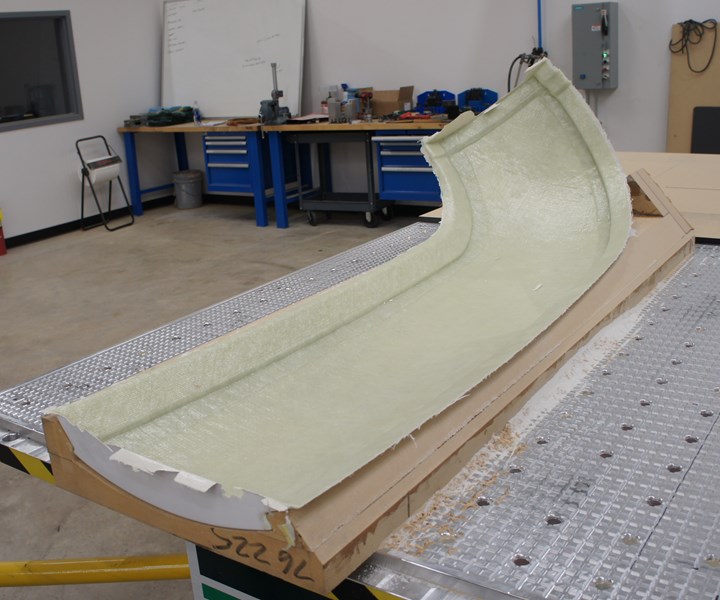
During MMS’s visit, DeltaWing set up this fiberglass body panel for Ollie, the autonomous bus developed by Local Motors, for trimming operations. Large, thin, contoured workpieces like this are common among the company’s aerospace and automotive work.
For DeltaWing, large-capacity five-axis capability is important for two reasons. First, a greater variety of jobs, tighter deliver schedules and more stringent quality control requirements leave no room for hand trimming composite parts that are too large and/or too complex for smaller equipment.

This CFRP ducting component (left) was cured in a CFRP mold (middle) created from an epoxy pattern (right). Without five-axis machining capability, pattern-making and trimming operations for this job would likely be impractical.
Mr. Bialas points out that trimming the large fiberglass bus panel depicted above could take as long as half an hour by hand, compared to less than 10 minutes on the new machine. As is the case with wing spars, tail booms and other large aerospace structures, machining this part also would be impossible without a sizeable workzone. Others, like the ducting component on the right, would require multiple setups on the company’s smaller machine tools. As for precision and repeatability, he says hand trimming the bus panel could achieve tolerances no tighter than ±0.015 inch, compared to the five-axis machine’s ±0.005 inch.
Second, large-volume five-axis capability has enabled the company to machine all its own patterns. A pattern is a replica of the final component, typically machined from epoxy tool board as the first step in producing a composite part. Curing layers of composite around this pattern forms a rigid mold with a service temperature of 350º to 450ºF.
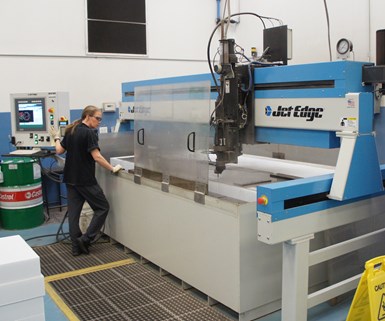
Large capacity isn’t just important for five-axis machining work. This waterjet handles 2D cutting.
For a company that aims to control its process, a step as critical as pattern-making is too important to leave to outside machine shops. When patterns were too large and/or complex to machine practically on the smaller VMCs and lathe, “We were essentially leaving our scheduling and quality control in someone else’s hands,” Mr. Bialas says. “Without a good pattern, you don’t get a good mold, and without a good mold, you don’t get a good part.”
Given that this goes for any composites manufacturer, DeltaWing devotes excess capacity to making patterns and trimming parts for others. Along with the discrete-parts business, this work has contributed to a threefold increase in direct machining revenue since the company’s deliberate shift toward new markets five years ago.
Thinking Beyond Metal
Based on testimony from DeltaWing personnel, programming an additional axis of motion did not present much of a learning curve. “The fact that we haven’t done a lot of square, simple parts over the years has been a real advantage,” says machine shop manager Ron Snarksy. However, cutting parts, patterns and fixtures from lighter, lower-density materials requires a different approach. He cites the following tools and strategies as critical to making the most of the new five-axis machine:
Sufficient filtration.
The new machine took longer than usual to install because the building that houses it — once a storage area — had to be fitted with adequate electrical power as well as an industrial filtration system from Camfil. This is critical because the Onsrud cuts materials that essentially turn to dust when machined. Even with the dust collection system, respirators are always on-hand for employees working nearby.
Cutting speedy and shallow.
Horsepower and chip load, which set the limits for metalcutting operations on the smaller machines, generally are not significant concerns for the new machine. It is designed specifically for fast, shallow cutting. The idea is to speed cutting by shaving thin layers of material in multiple passes rather than one deep pass, whether from light, porous fixtures; urethane and epoxy patterns; or CFRP, fiberglass and aluminum parts. To that end, the machine’s 15-horsepower spindle offers a maximum speed of 24,000 rpm (compared with 12,000 rpm for the other mills).
Sharp, serrated tools.
Although stepovers on the Haas equipment are generally limited to between 25 and 40% of the cutter’s diameter, full radial cutting tool engagement is not uncommon on the new machine. This is possible in part thanks to serrated flutes, which help ensure efficient evacuation of powdery machined material emerging from the cut.
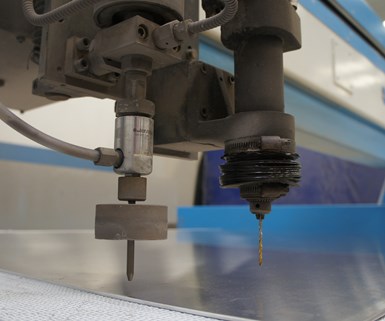
This drilling head was an important option for DeltaWing’s waterjet because piercing composite material with the abrasive-water stream can cause delamination.
For abrasive composites like CFRP, brazed tools can last longer. Brazed or not, edges must be sharp to shear cleanly through CFRP and other composite materials. Dull edges result in heat buildup that can melt the workpiece material’s bonding resin and lead the layers of composite pulling apart, a phenomenon called delamination. Delamination, as well as splintering, (essentially a less severe form of delamination) can also be a result of machining parameters that are too aggressive to let the cutting edge do its job. Drills should also be chosen with care to prevent fiber breakout through the back side of the hole. To this end, many of DeltaWing’s drills feature brad-point geometry that helps score the outer edges of the hole as the tool spins.
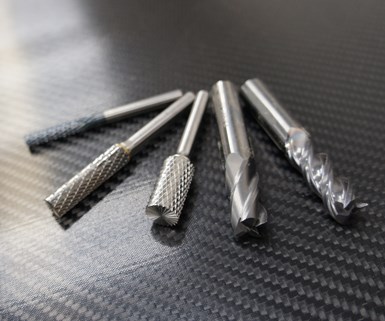
Examples of cutting tools employed on the large five-axis machine.
The right programming.
Making the most of the new machine required more than just upgrading the company’s MasterCAM software to support five-axis motion. One common composite machining strategy this software facilitates is moving the cutter up and down as it feeds. This oscillation spreads the cutting action over more of the edge to ensure even wear. Programmers have also found that carefully plotted five-axis tool paths can provide the same advantages with ballnose tools.
On-machine probing.
Using a spindle probe to inspect parts on the machine saves time in the event of rework, eliminates the need for hand-gage measurements and confirms proper setups. This is the case for both the large five-axis and smaller equipment. However, adding probes to the 12-position toolchanger on the new five-axis machine has been particularly beneficial. Parts too large for the CMM historically have been inspected with a portable measurement arm, but repeatedly moving this arm takes time and risks compromising precision.
Vacuum workholding.
The rigidity of materials like fiberglass and CFRP is an advantage for thin structures such as those used in aerospace applications. However, thin structures are also particularly subject to vibration during machining. Materials used for workholding and pattern-making also tend to be less dense than metals, and thus are more reactive to cutting forces. For most jobs, vacuum workholding is a necessity. “The most important part of machining is holding onto the part,” Mr. Snarksy says. “You can’t put any of this stuff in a vise or a clamp, or you’ll crush it.”
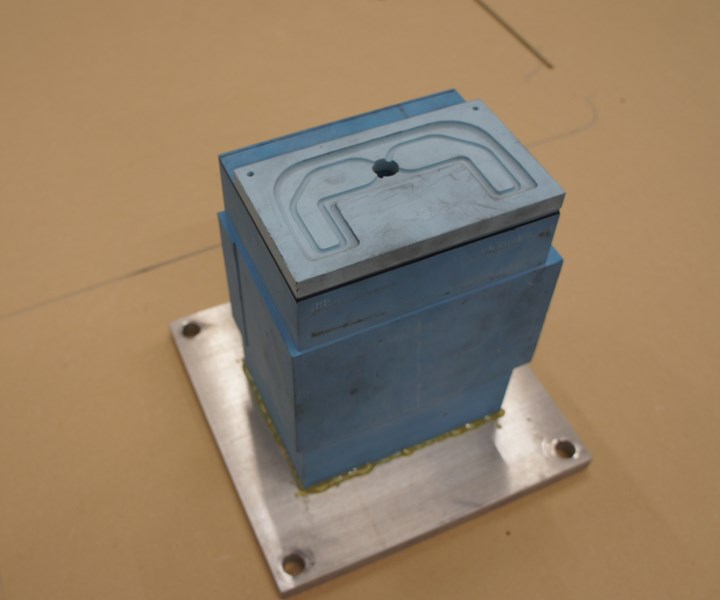
Holes and channels machined into vacuum workholding fixtures target clamping force where needed, even for smaller workpieces.
Epoxy tooling board for patterns typically arrives in billet form with flat bottoms that can be placed directly on the vacuum table. Holding parts for trimming is generally more complicated, requiring fixtures machined from porous materials and machined to match the underside of the workpiece geometry to form an airtight vacuum seal. Machining additional channels and bores into fixtures helps channel air and pressure where needed to ensure sufficient clamping force.
Some materials are particularly challenging, such as foam composite-part cores with densities as low as 3 lbs/ft.3 (for comparison, the same measurement is 42 lbs/ft.3 for epoxy and 168 lbs/ft.3 for aluminum). “Sometimes we have to hold things in place with hot-melt glue or two-sided adhesive tape,” he says.
Workzone-wide precision.
However well a machine tool is built, maintaining precision throughout a large workzone is challenging because the slightest imperfections amplify as machine axes get longer. At DeltaWing, machining tolerances can be relatively tight. Examples cited by Mr. Snarsky include hole position callouts as tight as ±0.003 inch and patterns requiring surface profile tolerances as tight as ±0.005 inch.
This is why the company purchased a volumetric error compensation package with the machine tool. Performed after machine installation by technicians from metrology company Automated Precision Inc. (API), this process is an alternative to traditional means of compensation that require multiple setups for multiple laser measurements. Instead, representatives from API use a laser tracker to create a map of possible tool-tip positions throughout the workzone. Feeding this information to the CNC facilitates real-time error compensation.
Whatever the merits of the method, volumetric error compensation “would never work if the machine weren’t precise in the first place,” Mr. Snarksy says. After all, the elements detailed above would be for naught were it not for a machine designed specifically to cut large, complex parts from plastics, composites and non-ferrous metals like aluminum.
If and when the company purchases another machine, it will be for a different purpose entirely. “We’re working on a quote right now, and the customer’s process requires some heavy-duty metal tooling that we have to outsource,” Mr. Bialas says. “We may add a second waterjet reasonably soon as well.”
Related Content
How to Accelerate Robotic Deburring & Automated Material Removal
Pairing automation with air-driven motors that push cutting tool speeds up to 65,000 RPM with no duty cycle can dramatically improve throughput and improve finishing.
Read MoreRead Next
How To Machine Composites, Part 1 -- Understanding Composites
Composites are replacing metal in certain applications. What does this mean for machining?
Read MoreEquipped for Composites
What machine tool features make sense for composites? A shop machining critical aircraft parts in both metal and composites describes the key features of the machine it bought with an eye toward CFRP.
Read MoreWet-Machining of Composites Crosses Boundaries
Although composite machining has traditionally been performed dry, new coolant technology has proven to prevent delamination, increase tool life and reduce health risks.
Read More


























.jpg;maxWidth=400;quality=70)
